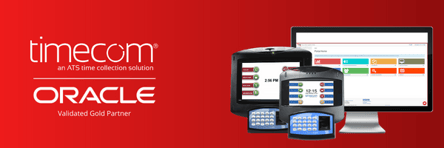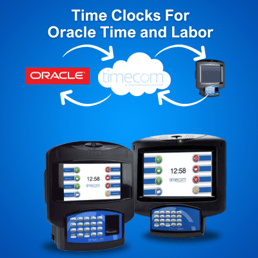%20-%20Data%20Collection%20that%20makes%20sense%20-%20Follwup%20graphic%20email.png?width=296&height=296&name=EATC2273%20-%20Intro%20to%20Timecom%20(3)%20-%20Data%20Collection%20that%20makes%20sense%20-%20Follwup%20graphic%20email.png) In today's employment landscape, companies encounter a multitude of challenges. Two of the greatest are managing employee turnover and a contingent workforce.
In today's employment landscape, companies encounter a multitude of challenges. Two of the greatest are managing employee turnover and a contingent workforce.
Fortunately, a workforce management system like Oracle Time and Labor provides numerous tools to help you manage both.
Workforce Management Solutions for Contingent Workers
The contingent workforce is growing, which complicates scheduling, employment management, and other workforce management issues. To avoid expensive complications, it is essential to adopt a distinct approach when managing contingent workers.
The Risks of Mixing Attendance Data and Payroll Systems
When both contingent workers and employees use the same systems for time and attendance tracking, it can cause problems. It risks their classification as contingent workers, which could expose your company to significant legal liabilities.
Contingent workers often earn different pay rates, based on different criteria, than employees. Workforce management software should accommodate these differences, ensuring human resources and payroll manage their time data and payments correctly.
The Importance of Data Integration
The integration of all attendance data is crucial for workforce management systems that use it to manage scheduling and worker performance. Sending all worker attendance data, both employees and contractors, from the time clock to your workforce management solution helps you optimize:
- Separating timekeeping or regular versus contingent workers
- shift scheduling
- Performance management
- Attendance and leave management
- Compliance management

With a total workforce management system, you can efficiently handle and oversee the data of both contingent workers and employees separately. It also allows you to analyze this data together for a complete view of your workforce.
Onboarding for Employees and Contractors
Your workforce management system must recognize the differences between employees and contingent workers during the onboarding process. This means avoiding accidentally sending benefits paperwork to contingent workers, ensuring a smoother and error-free experience.
Workforce Management Solutions for Reducing Employee Turnover
Replacing employees is an expensive and time-consuming task. You can use tools and reports from your workforce management solution to monitor employee separations, which drive employee turnover.
By understanding why employees leave, HR and management can take action to reduce turnover, saving money and expertise.
Analyzing Separation Patterns
Every company can expect some level of attrition. Workforce analysis can help you benchmark what is normal attrition for your industry and your organization.
Managing your workforce requires strategic allocation of your resources. Setting a company goal of achieving a churn rate that doesn't align with your industry norms isn’t a useful strategy. You can set a goal to do better than industry norms. If your industry experiences annual churn rates of around 20%, set a company goal for 15%, not one percent.
The analysis of your employee separation patterns can also provide insight into why people are leaving.
Your analysis may show that separation rates changed suddenly, which could be driven by specific departments or managers. That could indicate an upper or middle management problem or potential model for the rest of the company.
Voluntary vs Involuntary Separation within an Organization
Employee separation can be voluntary and involuntary. Each requires specific strategies to limit the turnover.
Minimizing Voluntary Separation
For voluntary separation, focus on retaining high-performing employees. Employee engagement and absence management reporting can help HR identify employees who might be thinking about leaving.
If a valued employee's attendance changes, it may mean they are unhappy at work. When you integrate TimeCom with Oracle Cloud Time and Labor, all the time clock data collected gets sent to Oracle. Managers and HR can view reports on attendance data that could show employees with:
- Increased unexcused absences
- Significant reduction in hours worked
- Increased tardies
 Managers and HR will recognize their valuable employees when they see their names on these reports. They can take pre-emptive action and check-in with those employees to avoid a possible voluntary separation.
Managers and HR will recognize their valuable employees when they see their names on these reports. They can take pre-emptive action and check-in with those employees to avoid a possible voluntary separation.
First, you need to define your criteria as to what qualifies as high performance. For example, stellar attendance may be an important criterion. Analyze the time and attendance data of your employees to accurately rank employees' overall schedule adherence rates and absenteeism rates. Then you can look for trends and anomalies.
Is an employee with previously stellar schedule adherence increasingly absent? Are employees with acceptable or stellar schedule adherence and low absentee rates voluntarily leaving at a high rate? Get proactive to learn why and put in retention strategies that target your high performers.
Look at the payroll history of high-value employees who left. What was the average length of time between raises? How long ago was their last pay increase or promotion? Look at recent benchmarks in compensation for your industry – is your company still competitive?
If HR is losing a lot of employees who quit, the problem might be with how they hire or manage performance.
Understanding Involuntary Separation
Firing an employee is common when they don't meet expectations. It's not a pleasant task, but it's necessary. Use workforce management tools to improve performance management. The goal is to turn the underperforming employee into a productive one, and to not let them go.
Use performance reviews, analysis of schedule adherence and absenteeism to identify employees who may need help before firing them.
A proactive, effective behavior modification program will cost less than having to recruit, replace, and train new employees. The program shows the company's commitment to support employees' professional development, reducing voluntary separation.
In an integrated TimeCom and Oracle environment, you will have the capability to assess these types of employees by analyzing the time they clocked in, how long they took for lunch, when they clocked out, how long they were on the clock and the amount of work they accomplished.

Reducing Labor Costs and Avoiding Downsizing
Revenue shortfalls and other external causes may put pressure on labor costs, which could lead to layoffs. Your workforce management solution should include key features that reduce payroll without layoffs.
Not using an automated timekeeping system wastes money on labor and administrative costs for payroll. The process of manually tracking employee time or using punch card attendance data entry is fraught with numerous human errors.
Integrating a time clock system into your workforce solution will immediately lower your labor and administrative costs. The employee user interface for tracking time is the time clock, which automates attendance data collection.
Integrating time clocks with Oracle Time HCM Cloud Time and Labor improves payroll accuracy and reduces processing time.
Analyze real time attendance in relation to productivity. This analysis can lead to improved employee scheduling that avoids overstaffing or high rates of overtime. Such measures lower labor costs, providing greater defense against layoffs.
The Protective Power of a Total Workforce Management Solution
Using these workforce management solutions can address two major workforce challenges: reducing employee turnover and effectively managing contingent workers.
A workforce management system that separates data of employees from contract workers, while allowing integrated data reporting, provides double protection. It prevents the mistaken classification of contingent workers as employees. It also empowers your company to monitor and optimize performance and costs across your entire workforce effectively.
The success of your Oracle Time and Labor solution depends on the time clock system you integrate with it. Choose a time clock solution that seamlessly integrates and collects data to maximize WFM software benefits.
While ATS is passionate about time and attendance, we recommend you reach out to your regional and/or local HR chapter for more information on common workplace advice and procedures.



%20-%20Data%20Collection%20that%20makes%20sense%20-%20Follwup%20graphic%20email.png?width=296&height=296&name=EATC2273%20-%20Intro%20to%20Timecom%20(3)%20-%20Data%20Collection%20that%20makes%20sense%20-%20Follwup%20graphic%20email.png) In today's employment landscape, companies encounter a multitude of challenges. Two of the greatest are managing employee turnover and a contingent workforce.
In today's employment landscape, companies encounter a multitude of challenges. Two of the greatest are managing employee turnover and a contingent workforce.

